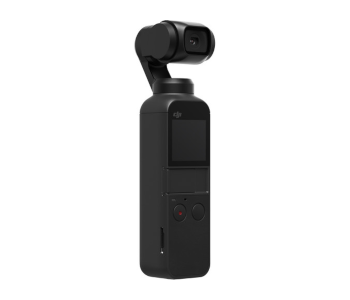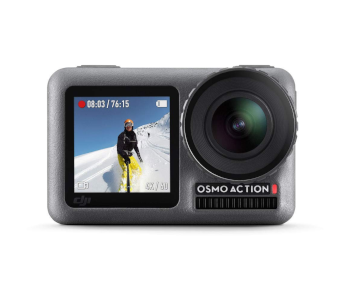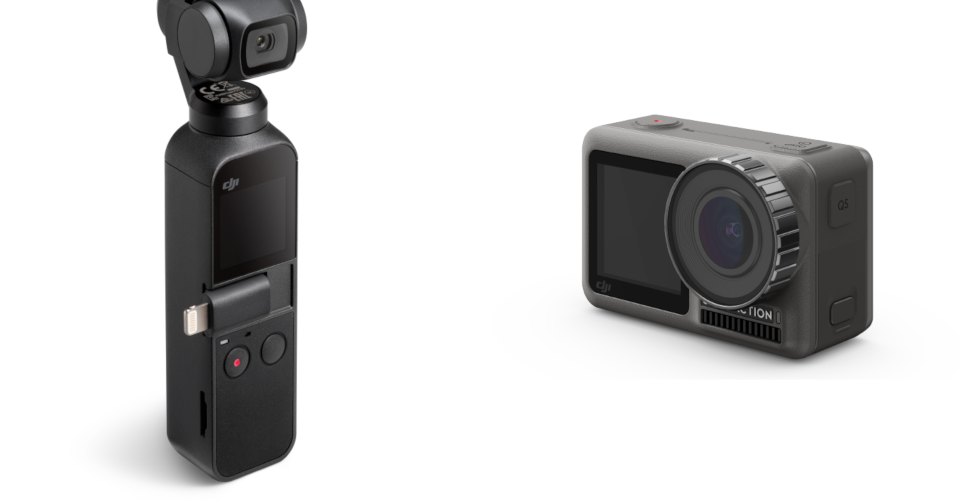DJI Osmo Pocket vs. DJI Osmo Action: Which One Should You Get?
Both the DJI Osmo Pocket and the DJI Osmo Action are excellent products in their own right. One is the smallest handheld gimbal that can shoot 4K video, while the other is a rugged action camera that can rival the quality of the GoPro Hero. While the video quality is excellent in either one, picking one over the other is a matter of how you intend to use it.
How do these two excellent cameras from DJI stack up against each other? If you can’t choose which one to get, then let us help you out with this article.
Build and design

When it comes to the Osmo Pocket and the Osmo Action, you probably cannot find two cameras that are more different from each other in terms of build and design. The Osmo Action looks a lot like the GoPro Hero – a small and lightweight action camera that measures just 2.6 inches on the longest side and weighs only 124 grams. Despite having a body that’s almost entirely made of plastic, it has been designed to withstand the most rugged of conditions. It’s dustproof, can withstand getting dropped, and can be used underwater to a depth of 5 meters.
The Osmo Pocket, on the other hand, looks just like a handheld gimbal except it’s small enough to fit in your pocket, hence the name. All the controls are integrated into the handle while the standalone camera is mounted on a mechanical arm that adjusts to keep the camera stable and leveled while you move. It’s longer but thinner than the Osmo Action and is even lighter at only 116 grams.
Both cameras offer excellent portability. Small and light enough to fit in your pocket, both the Osmo Action and Osmo Pocket are perfect choices for the amateur filmmaker or vlogger who is always on the go.
The Osmo Action has a glaring advantage over the Osmo Pocket, though: its rugged build. Built for action and adventure, the Osmo Action is built to withstand all manner of punishment. It can even be used to a limited capacity underwater. The Osmo Pocket has none of these features. We don’t know if it can withstand a fall from a small height, but we’re not going to try out luck with its fragile gimbal arms. It also has no underwater capabilities, unless you equip it with the recently released waterproof case for the Osmo Pocket.
Ease of use
Since they are both so small, fitting in all the essential controls in both the Osmo Pocket and Osmo Action might have been a challenge with DJI. Both cameras achieved this goal by keeping it simple: a few physical buttons, augmented by touchscreen controls thru an LCD screen.
If we’re talking about screens, then the Osmo Action is the clear winner. It features a 2.2-inch touchscreen at the back and another 1.4-inch screen at the front. Not only does it make it easier to access many of the camera’s finer controls, but it’s also a great tool for capturing selfies and for vlogging. Both the screens of the Osmo Action have been treated with an anti-stain coating that keeps away fingerprints, oils, water, dust, and other small particles.
On the other hand, the Osmo Pocket features a much smaller 1.08-inch touchscreen that allows you to change up many of the camera’s settings and also acts as the camera’s viewport. It’s not the most comfortable of touchscreen interfaces, so it’s best to hook up the Osmo Pocket to your smartphone via the DJI MIMO app. Through the app, you can use your phone as an extended display and enable more advanced camera options.
The Osmo Action also keeps thing simple with just three physical buttons and the rest of the controls done either via the touchscreen interface or the DJI MIMO app. The control scheme should feel very familiar for anyone who has ever used a GoPro action camera. What sets the Osmo Action apart is its voice control feature, which is responsive, albeit limited in the commands that it can recognize. The Osmo Action still has a long way to go before it can be a “smart” device, especially since the GoPro cameras have much wider voice control features, but this is a step in the right direction.
Another advantage of the Osmo Action over the Osmo Pocket is the SnapShot feature. When you start recording videos quickly, all you need to do is to press the shutter button on the Osmo Action – even if the camera is turned off. In just two seconds, the Osmo Action can start recording videos. The activation time for the Osmo Pocket takes around 5 to 6 seconds, which isn’t bad but compares poorly with the Osmo Action.
All in all, the control schemes of both the Osmo Action and the Osmo Pocket are similarly user-friendly and easy to learn. If there’s a major point in criticism, it will have to be the clunky and poorly designed DJI MIMO app. However, this issue can be easily remedied by DJI with a simple app relaunch. We’re crossing our fingers that improvements in the companion mobile app will come soon.
We’ll give the slight edge in user experience to the Osmo Action, just because of the addition of voice controls and the SnapShot feature. Both models feature the same brand of ease-of-use that DJI has perfected over the years in their drones and camera products.
Video quality

The camera hardware of both the Osmo Action and the Osmo Pocket are virtually identical – 1/2.3-inch CMOS sensors that can shoot 12 MP stills and 4K video at 60 fps. The field-of-view of the Osmo Action is a much wider 145 degrees, which makes the 80-degree FOV of the Osmo Pocket pale by comparison.
Since the Osmo Action was meant to capture footage in more rugged conditions, DJI has clearly designed it to be the more capable camera. It has a built-in HDR mode that automatically enhances contrast in challenging lighting conditions, resulting in brighter brights and darker darks.
The Osmo Action also has a hugely upgraded slow-motion feature that can capture up to 240 fps of HD video. By comparison, the Osmo Pocket’s slow-motion mode can only record at the same resolution with a framerate of 120 fps – not bad in most standards, especially if it weren’t being compared with the Osmo Action.
Both cameras have fixed apertures, although the Osmo Pocket holds the edge with its slightly faster f2.0 aperture compared to the Osmo Action’s f2.8 aperture. They also have the same 100 to 3200 ISO range. In low-light conditions, you can expect the Osmo Pocket to perform slightly better. Both cameras, however, will suffer when the lighting conditions are extremely bright. The good news is that you can easily buy good ND filter sets for both cameras from reputable brands.
Battery
Both the Osmo Action and the Osmo Pocket will give you substantial shooting time in a single battery cycle. The Osmo Pocket holds the slight edge with 140 minutes when shooting 1080p video at 30 fps, while the Osmo Action can only last up to 135 minutes in the same conditions. The Osmo Pocket’s battery also only need to be charged for 73 minutes compared to the 90 minutes charging time for the Osmo Action.
Where the Osmo Action shines as the more on-the-go camera is with its provision for a removable battery. This allows you to carry several spare batteries with you, which could be extremely useful for trips that can last a few days. DJI also sells a three-slot charger for multiple Osmo Action batteries.
On the other hand, the non-removable battery of the Osmo Pocket means that hot-swapping the battery at the middle of the shoot is not an option. Should your battery run out of juice while in the middle of a shoot, your only recourse would be to charge it with a portable power bank. Considering that the main selling point of the Osmo Pocket is it’s light and handheld design, adding a power bank to the mix kind of ruins the entire point of the device.
Image stabilization
DJI has pretty much perfected the craft of video stabilization through their extensive line of camera drones. For this reason, the expectations for the stabilization performance of the Osmo Pocket are very high. Like any handheld gimbal, the Osmo Pocket has motorized arms that move in response to any movement of the gimbal, keeping the camera perfectly leveled and the video remarkably stable. We’re happy to report that the video stabilization of the Osmo Pocket satisfies even the most demanding expectations.
In contrast, the Osmo Action uses a purely digital stabilization technology. This feature, called RockSteady, was introduced by DJI with the Osmo Action and easily outperforms the HyperSmooth feature from GoPro. There is some slight image cropping when RockSteady is activated, but the quality of stabilization is impeccable. There was a time when digital stabilization technologies coming close to the performance of mechanical stabilization was practically unheard of, but the Osmo Action may be the first camera to defy that standard.
In terms of raw quality of stabilization output, we’ll have to declare it a toss-up between the Osmo Pocket and the Osmo Action. Either one of these cameras can produce remarkably stable videos even when undergoing rapid movement. Given the DNA of the Osmo Pocket, this excellent performance is all but expected. The fact that the Osmo Action performs equally as well is a revelation, though, and is a testament to how far digital stabilization technologies have come.
Smart features and camera modes
Another useful characteristic that both the Osmo Action and the Osmo Pocket have inherited from DJI’s extensive line of camera drones is their range of smart camera modes and features. Both cameras are capable of all the basic camera features, such as slow-motion, time-lapse, timed shots, and burst mode. The Osmo Pocket even throws in a Motion Lapse mode into the mix, which basically a time-lapse mode with added motion capabilities.
Both cameras can be used to take long exposure shots, but the Osmo Action has the option of slowing down the shutter speed up to 120 seconds – a far cry from the 8 seconds that the Osmo Pocket offers. If you want a compact camera that you can use for good star trail photography, then the Osmo Action is a much better choice.
What the Osmo Pocket offers are more cinematic camera modes. The ActiveTrack mode can be used to allow the gimbal to automatically adjust to keep a certain subject in focus. The FaceTrack feature is merely a variant of ActiveTrack which can be used for highly dynamic “selfie” videos. The Tilt Locked mode is perfect for capturing videos of subjects that move forward or backward, and the gimbal can even go into Flashlight Mode for capturing videos in narrow spaces. If you want your videos to more accurately convey motion, then just simply activate FPV Mode. With relaxed stabilization, filming in FPV Mode creates videos that have a more immersive and action-filled atmosphere.
Accessories
Being particularly popular products, there is a whole range of accessories that are already available in the market for both the Osmo Action and the Osmo Pocket. The Osmo Action does have a huge advantage, though: it’s compatible with most of the accessories that have been designed for the massively popular GoPro action cameras. Since GoPro cameras have been around for ages, the ecosystem of accessories that are compatible with them – and therefore, the Osmo Action – is huge. You can go on a veritable shopping spree for a variety of mounting options, handles, tripods, frames, and cases for the Osmo Action.
The accessories for the Osmo Pocket, although less impressive in volume, isn’t exactly underwhelming, either. The basic wireless module, smartphone adapter, and the controller wheel from DJI are some of the most useful accessories you can get, greatly enhancing the capabilities of the Osmo Pocket. You can also get a handy tripod stand or backpack clip that can make shooting with the Osmo Pocket much easier. More recently, DJI has announced the release of the long-awaited waterproof case for the Osmo Pocket which allows it to be used underwater.
We’ll have to give the win to the Osmo Action for this category. With years of development behind the GoPro action cameras, the accessories that are available for the Osmo Action have become so much more versatile, accessible, and affordable. The Osmo Pocket, on the other hand, is a specialty product- there’s nothing like it, so it’s no surprise that the selection of Osmo Pocket accessories is much more limited.
Price
Both the Osmo Pocket and the Osmo Action are some of the most affordable, high-end compact cameras in the market. The Osmo Pocket costs about $50 more than the Osmo Action, though, so we’ll have to give the edge to the Osmo Action. It’s also worth noting that the Osmo Pocket is slightly cheaper than its closest market rival, the GoPro Hero 7. There’s no product quite like the Osmo Pocket, though, so a similar comparison can’t be made in this case.
Get the Osmo Pocket if…
1. If you want a camera for vlogging or more traditional filmmaking
The Osmo Pocket is pretty much the vlogger’s dream camera. It’s incredibly light and small, has all the essential controls within reach of your fingers, and produces remarkably stable and high-resolution videos. It’s not all-weather, rugged camera, and the Osmo Action can capture much better slow-motion footage, but it does offer camera modes that have a more cinematic effect.
If you intend to use the Osmo Pocket for professional vlogging or filmmaking, you will have to invest in a good set of accessories. You’ll definitely want to get smartphone adapter and an external microphone.
2. If you need to capture videos in low light
The Osmo Pocket had a wider fixed aperture, so it should perform much better in low light compared to the Osmo Action. However, you’re still going to need a good set of ND filters to avoid overexposed shots when shooting in harsh lighting.
Get the Osmo Action if…
1. If you need a camera that can withstand the roughest conditions
One of the distinguishing characteristics of the Osmo Action is that it’s an action camera with a build quality that can rival the very best action cameras from GoPro. This means that the Osmo Action can withstand water damage, dust, falls from a short height, or even getting submerged in water. Simply put, the Osmo Pocket is not built for any of these conditions.
2. If you need to capture fast-moving subjects
The 8x slow-motion mode of the Osmo Action is among the best in the market of compact cameras, and up to par with the GoPro Hero 7. If you anticipate that you’ll be capturing a lot of slow-motion footage, then you are not going to go wrong with the Osmo Action.
3. For long stretches of filmmaking
If you want to capture footage on some outdoor trip that will stretch to a few days, then the Osmo Action is uniquely suited to handle your needs. With its provision for removable batteries, you can bring several spare batteries, so you’ll never have to worry about having to recharge your camera. Having just three batteries can give you up to 7 hours of continuous video recording with the Osmo Action – just don’t forget to pack several microSD cards as well.
Final thoughts
Both the Osmo Pocket and the Osmo Action have been excellent additions to DJI’s line of compact and lightweight cameras. They represent a new paradigm of filmmaking that affords freedom of movement without being burdened by the problem of unstable and jittery videos. If you want to produce high-resolution and remarkably stable videos no matter the conditions, then either one of these cameras will not disappoint.
The unique value proposition of the Osmo Action lies in its action camera build. It’s basically indestructible, can be mounted on a variety of surfaces, and features removable batteries. The Osmo Pocket, although a less tough version, offers a more cinematic filmmaking experience.

